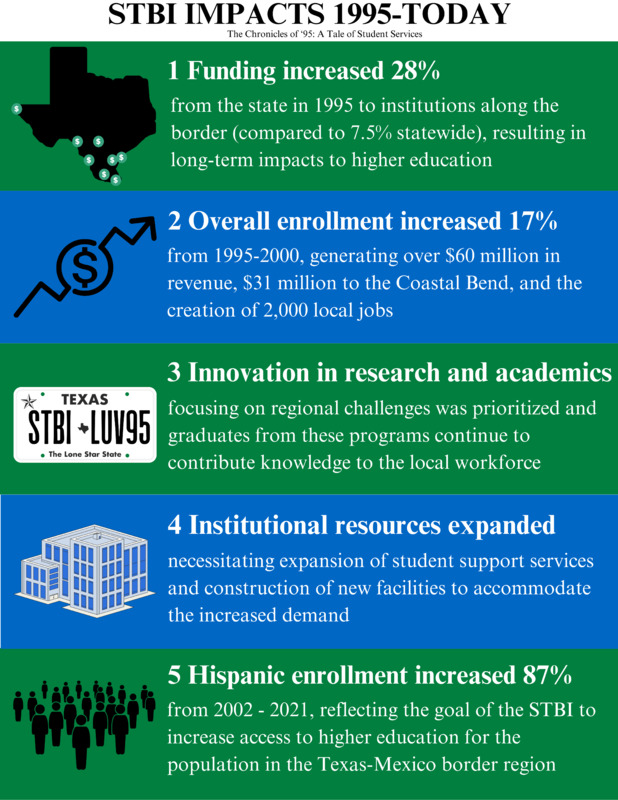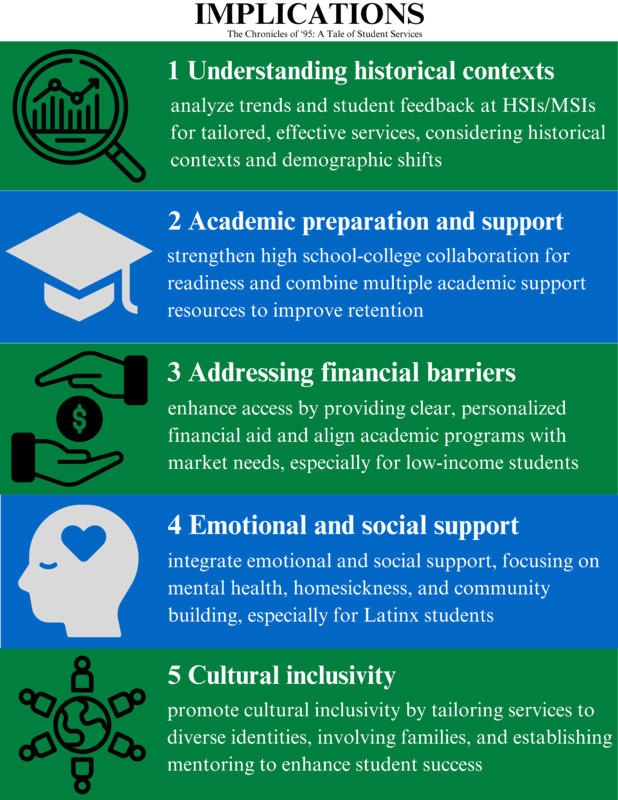The Chronicles of ’95: A Tale of Student Services
By: Lori Flaminio
Introduction
nce upon a time, on an island not so far away, a wondrous transformation in public higher education occurred. In 1995, just one year after becoming a four-year temple of knowledge (Young), Texas A&M University-Corpus Christi (TAMU-CC) opened its gates to welcome the second freshmen class of 460 students ready to embark on their scholarly journeys (Ullrich, 2023).
Forty-three of these brave seekers of wisdom documented their fall semester experiences as letters to the future, which were preserved as precious artifacts and later discovered in the Mary & Jeff Bell Library Archives. The Chronicles of ’95 offer a rare glimpse into past narratives and historical challenges students faced in South Texas. From academic labyrinths and social gauntlets to fire-breathing dragons preventing access to financial treasure, enrollment obstacles have deterred many a noble heart from completing their educational quest.
According to Harvey (2003), students are the heart of academia, and their perspectives are of great value in enhancing the educational experience of the future. This digital exhibition connects historical experiences to current student services designed to support success. Understanding and addressing enrollment barriers is crucial for institutions and policymakers who want to ensure that all who seek knowledge can fulfill their scholarly destinies.
Background
The STBI
Stories of TAMU-CC cannot be told without mentioning the South Texas Border Initiative (STBI), which aimed to increase access to higher education for the predominantly Hispanic population in the Texas-Mexico border region and resulted in a 28% increase in 1995 state funding to institutions along the border, compared to 7.5% statewide (Calderon Galdeano, 2014).
This investment in the region has had significant long-term effects on Corpus Christi and the surrounding area. Enrollment increased by 17% from 1995-2000, generating over $60 million in revenue (of which 90% came from outside the area), $31 million to the local economy from spending, and the creation of 2,000 local jobs that produced over $273 million in personal income (Institute of Education Sciences, 1998). From 2002 to 2021, enrollment of Hispanic students increased by 87% at TAMU-CC (Texas A&M University-Corpus Christi, 2022). Today’s economic impact of the STIBI is $644 million, with $1.1 billion in additional lifetime earnings to Coastal Bend residents (Lee, 2023).
New research and academic programs reflecting regional challenges were prioritized due to student diversity and growth. Graduates from these enhanced programs continue contributing to the local and regional workforce, driving further development through their skills and knowledge (Abel & Deitz, 2012). Increased educational demand necessitated expansion in institutional resources, including the construction of new facilities and the expansion of student support services (Johnson, 2021). The STBI’s success in increasing access to higher education has had a domino effect, influencing various aspects of university operations and their ability to serve the student body effectively.
The Slackers
In addition to the effects of the STBI, understanding higher education in the context of the mid-90s requires recognizing the unique landscape of the time. These students were part of Generation X (also known as Gen X or the Slacker Generation), negatively stereotyped as lazy, directionless, and craving entertainment that could be enjoyed with a short attention span (Townsend, 2020).
In the post-Cold War era, the early 90s saw a recession and increased unemployment in the United States. Although the economy was recovering by 1995, many students still faced economic hardships (Aborn & Cahill, 2020). Socially, there was a resurgence of student activism, with movements addressing various issues, including race, sexual orientation, environmental concerns, global human rights, and domestic political policies. College campuses were often hubs for this activism, reflecting Gen X’s response to growing up in this era of challenges (Rhoads, 1998). Technologically, the emergence of the Internet, personal computers, and improvements in electronic content delivery began transforming learning and communication (Dunning et al., 2007).
Navigating the complexities of the first semester of college and adulthood can be a period of significant change and difficulty, regardless of generation (Landino, 2016). In 1995, Dr. Libby Allison from TAMU-CC’s English Department assigned her first-year students a unique project of writing letters to their future grandchildren, describing life as a new college student (A&M Student Letters to the Future, 1996). The writings delve into the students’ reflections on their initial experiences and perspectives on contemporary issues. Several themes are revealed, including some specific to historical barriers to higher education.
Analysis
Three themes from the Chronicles of ’95 that reflect challenges faced by students entering higher education in South Texas were identified. These themes include:
- College is Different: A lifetime of experiences shaped students’ expectations for their first semester of college. They mentioned the challenges and learning curves faced when transitioning from high school, ranging from study habits and time management to coping with increased independence and technological demands. When student expectations for the first semester of college match reality, persistence increases (Williams, 1999).
- Financial Concerns: Students have historically perceived financial problems as a primary barrier to enrollment (Brock, 2010). The narratives provide a window into the various financial struggles faced by college students in the mid-1990s, encompassing issues such as budgeting, the cost of living, and the broader economic context impacting their lives.
- Homesickness: Homesickness is a universal experience for any human, regardless of age, gender, or cultural background (Ferrara, 2020). Experiences covered a range of emotions and situations, such as missing family members, dealing with long-distance relationships, and struggling to be in a new and unfamiliar environment. Each person reflects on the common feelings of adjustment and the longing for familiar comforts and connections. Emotional factors like homesickness and loneliness can significantly impact retention (Boddy, 2020).
These findings beg the question: How can contemporary student services address issues affecting students at TAMU-CC for decades?
Implications
The archival exploration of students’ experiences, documented in the Chronicles of ’95, alongside the contextual backdrop of the South Texas Border Initiative (STBI), offers profound implications for contemporary educational practice, particularly at Hispanic-Serving Institutions (HSI) and Minority-Serving Institutions (MSI), like TAMU-CC. While some aspects of these challenges have evolved, they persist as significant barriers to enrollment and success. Some strategies to consider in providing services that support students and their families in the transition to higher education are:
- Understanding Historical Contexts: The shift in student demographics, notably influenced by the STBI, and the challenges of the mid-90s highlight the need to understand the historical backgrounds of student populations (Garibay et al., 2020). This understanding is essential for creating effective student services (Tinto, 1993). HSI/MSIs should conduct analyses of enrollment and retention trends, identify critical factors affecting their students, and develop support programs that align with the institution’s unique identity and student demographic (Brown et al., 2023). Continuous evaluation and incorporating student feedback are critical for refining student services and ensuring their effectiveness (Harvey, 2003).
- Academic Preparation and Support: Over one-third of all first-year students require some form of remedial coursework, often necessary due to inadequate high school preparation, which delays degree completion and imposes additional financial burdens on students (Long, 2014). Student services should focus on strengthening the collaboration between secondary and higher education institutions. This would involve aligning high school curricula with college expectations and promoting college readiness in regional high schools to improve students’ academic preparation for college (Martorell & McFarlin, 2011).
For HSI/MSIs, combining academic intervention resources, like academic advising, academic coaching, freshmen seminars, and peer mentoring, improves student retention rates compared to just a single approach. Specifically, examining data from different cohorts is recommended to objectively determine which attrition factors are statistically significant for minoritized students in their institutions (Brown et al., 2023).
Student orientation programming should include information and resources to help incoming students develop realistic expectations for the academic demands of college. Sessions focused on navigating the higher education system, managing time, overcoming imposter syndrome, and creating a sense of community among new students are critical in serving new students (Ward-Roof, 2010).
- Addressing Financial Barriers: The Chronicles of ’95 underscore the persistent challenge of financial barriers to college access and success (Baum & Flores, 2011). Affordability remains a critical barrier, making higher education increasingly inaccessible for many students, particularly those from low-income backgrounds. In 2010, about 82% of students from high-income families attended college compared to only 52% from low-income families, and the gap in college completion rates between these groups is significant (Long, 2014). Student services can enhance enrollment and retention by alleviating financial barriers through personalized aid counseling, simplifying the process, and ensuring that aid information is transparent and easily understandable to aid decision-making (Gallup & Lumina Foundation, 2023-b; Levine, 2022).
HSI/MSIs should prioritize financial support systems, including scholarships, grants, and work-study programs, specific to the needs of their student populations, especially in regions with significant economic disparities (Klasik, 2012). Coordination of financial aid services with other student programming, like orientation, enhances the overall effectiveness of financial support offered to Latinx students (Venegas, 2015).
Emergency aid and hardship grants to alleviate financial stress help improve students’ perceptions of institutional care and a sense of belonging (Wagner et al., 2021). These financial aid options are seen as most helpful by unenrolled adults, including those from minority and economically disadvantaged backgrounds.
In response to the rising costs and declining public perception of the value of higher education, institutions should align academic programs with market needs to enhance career outcomes (Caron & Muscanell, 2022). This includes communicating the economic advantages of investing in education and its positive impacts on regional well-being, civic engagement, and personal development (Gallup & Lumina Foundation, 2023-a; Orphan & McClure, 2022).
- Emotional and Social Support: As noted in the archival letters, the prevalence of homesickness and emotional stress calls for a robust support system integrated throughout the enrollment experience. Understanding the emotional aspects behind students’ enrollment decisions can help design more effective retention strategies beyond academic and financial support (Boddy, 2020). Many students point to emotional stress as influencing their decision to consider stopping out, particularly Black, Hispanic, male, and students from areas with strong family bonds, like South Texas (Gallup Lumina Foundation, 2023-b; Wilson et al., 2018).
Providing mental health counseling and support services that focus on coping strategies for homesickness is essential (Ferrara, 2020). For student services at an HSI/MSI, this implies a need for proactive engagement with Latinx students, especially in their freshman year, to aid in their academic and social integration (Benavides et al., 2022). Orientation activities should be designed to acknowledge and address homesickness directly (Claborn & Kane, 2019) and address the barriers to counseling, such as stigma and time constraints, to improve students’ awareness and understanding of these services (Huenergarde, 2018). It also suggests the importance of creating and promoting targeted support systems programs that facilitate connections with faculty and peers, supporting the development of a strong sense of belonging among first-generation Latinx students (Becerra, 2010; Clark et al., 2013).
- Cultural Inclusivity: There is an increasing enrollment of students with multiple and intersecting minoritized identities, including LGBTQIA+ students, but retention, completion, and success rates for these students remain low (Gonzalez & Cataño, 2022). These challenges highlight the need for HSI/MSIs to cultivate an inclusive campus environment that respects diverse cultural backgrounds and demystifies “the hidden curriculum” not explicitly taught in the classroom (Benavides et al., 2022, p. 3). For student services, this underscores the importance of balancing efforts to enhance institutional prestige with the need to ensure equitable access and support for all students, especially those from underrepresented backgrounds (DeTurk & Briscoe, 2021). Student services professionals should tailor services to meet diverse student populations’ cultural contexts and needs, especially first-generation students (Benavides et al., 2022).
Institutions serving significant Latinx populations should also facilitate parental involvement in educational planning and decision-making, provide resources that meet the needs of their specific populations, and leverage families’ unique cultural wealth in supporting their children’s educational journeys (Palomin, 2020). Establishing clear communication and mutual information flow with Latinx families is critical (Chlup et al., 2018) and can be accomplished partly by providing resources and information in languages other than English (Deeb-Sossa et al., 2021). Lastly, mentoring relationships are impactful for Latino male first-year college students, helping them improve a sense of belonging, which improves retention and success (Luis et al., 2023).
In addition to these specific strategies, systemic changes will be necessary to make higher education more accessible and navigable for all students, especially those from underrepresented backgrounds (Texas Legislative Budget Board, n.d.). Students with the greatest needs often attend the least-funded institutions, offering fewer resources, support services, and opportunities (Labaree, 2017). This stratification impacts the educational experience and future career prospects of lower-income and commuting students (Mintz, 2023).
Conclusion
The Chronicles of ’95 weave wisdom from the past into the fabric of South Texas’ educational tapestry. These narratives, rich with lore and lessons, shine a guiding light for sculpting the scholarly practices in this vibrant land. From the timeless challenges of readiness, the shackles of financial constraints, and the aching pain of homesickness, each story bears witness to the trials of scholarly pursuits. However, they also help explain new winds blowing, shifting perceptions of the value of higher education, and foretelling changes in the seas of demographics, notably a foreseen decline in the number of youth ready to embark on the collegiate voyage (Kline, 2019).
In this ever-evolving landscape, student services professionals emerge as valiant champions. With wisdom and foresight, they navigate these multifaceted challenges, standing as steadfast pillars in the grand halls of higher education. Like the cornerstone of a great fortress, their role is pivotal in these institutions’ strategic sustainability, especially in the dynamic and ever-shifting realm of South Texas. Their adaptability is a beacon of hope, ensuring that every aspiring scholar, regardless of their path or challenges, can attain their quest for knowledge, contribute meaningfully to a democratic society, and live happily ever after.
References



